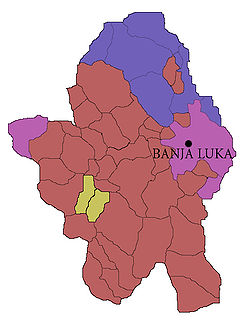
Historical population of Banja Luka
Encyclopedia

Banja Luka
-History:The name "Banja Luka" was first mentioned in a document dated February 6, 1494, but Banja Luka's history dates back to ancient times. There is a substantial evidence of the Roman presence in the region during the first few centuries A.D., including an old fort "Kastel" in the centre of...
.
Population growth
Note: The population figures for 1969 and onwards are for the entire Banja Luka metropolitan areaMetropolitan area
The term metropolitan area refers to a region consisting of a densely populated urban core and its less-populated surrounding territories, sharing industry, infrastructure, and housing. A metropolitan area usually encompasses multiple jurisdictions and municipalities: neighborhoods, townships,...
.
| Year | Population |
| 1895 | 13,566 |
| 1939 | 32,000 |
| 1971 | 158,736 |
| 1981 | 183,618 |
| 1991 | 195,139 |
| 1999 | 220,000 |
| 2004 | 222,000 |
Historical data
- 1879. Banja Luka district
Population 86209, Orthodox 64 186, Muslims 12 350, Catholics 9 486, Jews 187.
- 1879. Town Banja Luka, Population 9 560, Muslims 6 474, Orthodox 1 893, Catholics 1 006, Jews 187.
- 1910. Banja Luka, city (48 km²)
Overall population 14800, Orthodox 3 694, Muslims 6 588, Catholics 3 930.
- 1910. Banja Luka, village district (1 614 km²),
Overall 58 360, orthodox 41 414, Muslims 2 436, Catholics 14 052.
- 1921. Banja Luka, city
Overall: 18 001, orthodox: 5 324, Catholics: 4 718, Muslims: 7 201, Jews: 484.
- 1921. Banja Luka, district
Overall: 59 578, orthodox: 41 511, Catholics: 15 159, Muslims: 2 364, Jews: 1.
- 1948. Banja Luka, city
Overall: 31 223, Serbs: 10 861 (34, 78%), Croatian: 8 662, Muslims: 9 951.
- 1948. Banja Luka, canton
Overall: 89 248, Serbs: 64 599, Croats: 21 150, Muslims: 2 622.
- 1971. Municipally of Banja Luka
Overall: 158 736, Serbs 92 465, Croats 33 371, Muslims 24 268, Yugoslav 4 684.
- 1981. Municipally of Banja Luka,
Overall: 183 618, Serbs 93 389, Yugoslav 31 347, Croats 30 442, Muslims 21 726...
- 1981. City of Banja Luka
Overall: 123 937, Serbs: 51 839, Yugoslavs 29 176, Muslims 20 916, Croats 16 314.
- 1991. Municipally of Banja Luka,
Overall: 195 692, Serbs: 106 826 (54, 58%), Croats 29 026, Muslims 28 558, Yugoslavs 23 656.
- 1991. City of Banja Luka
Overall 143 079, Serbs 70 155, Muslims 27 689, Yugoslavs 22 645, Croats 15 700.
Percentage breakdown
City of Banja LukaBosnian Muslim (from 1994 Bosniaks)
- 1879 – 67.72%
- 1910 – 44.51%
- 1921 – 40.00%
- 1948 – 31.87%
- 1981 – 16.88%
- 1991 – 19.35%
Orthodox Serbs
- 1879 – 19.80%
- 1910 – 24.96%
- 1921 – 29.58%
- 1948 – 34.78%
- 1981 – 41.83%
- 1991 – 49.03%
Catholics (from 1948 Croats)
- 1879 – 11.00%
- 1910 – 26.55%
- 1921 – 26.21%
- 1948 – 27.74%
- 1981 – 16.58%
- 1991 – 13.16%
Yugoslavs
- 1981 – 23.54%
- 1991 – 15.82%
Municipality of Banja Luka
Bosnian Muslim (from 1994 Bosniaks)
- 1879 – 14.33%
- 1910 – 4.17%
- 1921 – 3.97%
- 1948 – 2.93%
- 1971 – 15.29%
- 1981 – 11.83%
- 1991 – 14.59%
Orthodox Serbs
- 1879 – 74.45%
- 1910 – 70.96%
- 1921 – 69.68%
- 1948 – 72.38%
- 1971 – 58.25%
- 1981 – 50.86%
- 1991 – 54.58%
Catholics (from 1948 Croats)
- 1879 – 10.52%
- 1910 – 26.55%
- 1921 – 25.44%
- 1948 – 23.70%
- 1971 – 21.02%
- 1981 – 16.58%
- 1991 – 14.83%
Yugoslavs
- 1971 – 2.95%
- 1981 – 17.07%
- 1991 – 12.09%
Analysis
Generally speaking it is clear that there was a sharp drop in Bosniak population natality in the City of Banja Luka since 1879 until 1991 with only slight recovery in period from 1981 to 1991.It is also clear that there was a sharp and consistent increase of Serb population in the City of Banja Luka from 1879 to 1991.
Croat population remained relatively the same in the City of Banja Luka with a gradual decline starting after WWII.
On the municipal level numbers tend to stay relatively the same. It is noted that Serb population has declined as some of the rural parts were included in the City of Banja Luka proper and also because of in-migration after the 1969 earthquake.
There is a sharp drop in Bosniak population on the municipal level noted on 1910 what can be attributed to several factors, including massive emigration (partly due to Agrarian Reform) and including the fact that many Bosniaks had to declare themselves as Croats, Serbs or undecided Muslims until 1971 when their national identity was created.

